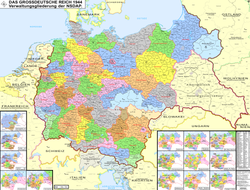Gau Pomerania
| Gau Pomerania | |||||
| Gau of Nazi Germany | |||||
|
|||||
|
Flag |
|||||
| Capital | Stettin | ||||
| Gauleiter | |||||
| • | 1931–1934 | Wilhelm Karpenstein | |||
| • | 1934–1945 | Franz Schwede-Coburg | |||
| History | |||||
| • | 1931 | ||||
| • | Disestablishment | 8 May 1945 | |||
| Today part of |
|
||||
Flag
The Gau Pomerania (German: Gau Pommern) was an administrative division of Nazi Germany from 1933 to 1945 in the Prussian province of Pomerania. Before that, from 1931 to 1933, it was the regional subdivision of the Nazi Party in that area. Most of the Gau became part of Poland after the Second World War while the remainder became part of what would become East Germany.
The Nazi Gau (plural Gaue) system was originally established in a party conference on 22 May 1926, in order to improve administration of the party structure. From 1933 onwards, after the Nazi seizure of power, the Gaue increasingly replaced the German states as administrative subdivisions in Germany.
At the head of each Gau stood a Gauleiter, a position which became increasingly more powerful, especially after the outbreak of the Second World War, with little interference from above. Local Gauleiter often held government positions as well as party ones and were in charge of, among other things, propaganda and surveillance and, from September 1944 onward, the Volkssturm and the defense of the Gau.
The position of Gauleiter in Pomerania was held by Wilhelm Karpenstein from 1931 to 1934, followed by Franz Schwede-Coburg from 1934 to 1945. Pomerania's original Gauleiter, Karpenstein, survived the war and died in 1968. Its second, Franz Schwede, was the first Nazi Party member to become Major of a German city, Coburg in Bavaria, and was therefore awarded the honorary addition of Coburg to his name by Adolf Hitler. Highly anti-Semitic Schwede-Coburg had the last Jews in Pomerania deported in early 1940 and thereby made the Gau the first to be Judenrein, free of Jews. When Soviet forces reached Pomerania he delayed the order of evacuation, thereby abandoning much of the population and goods behind enemy lines. His insistence in sending under-trained Volkssturm units into battle caused Pomerania to have the third-highest Volkssturm casualty of all German Gaue. He escaped from Pomerania but was captured by British forces. Sent to prison for 10 years in 1948 he died in Coburg in 1960.
...
Wikipedia


